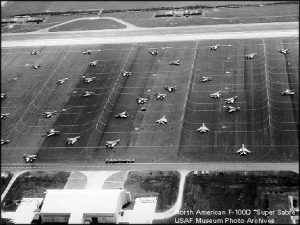28 October 1962 – “Soviet Premier Nikita Khrushchev orders the withdrawal of missiles from Cuba, ending the Cuban Missile Crisis.

AVIANO AIR BASE, Italy — “During this period, when the maintenance of world peace was so seriously threatened, the officers and Airmen of the 31st Wing performed their vital mission in a truly professional manner.”
-Col. Frank J. Collins, 31st Tactical Fighter Wing commander
In the White House briefing room, on the morning of Oct. 16, 1962, Central Intelligence Agency imagery analysts briefed John F. Kennedy, president of the United States of America, that medium-range ballistic missiles had been discovered in Cuba. The missiles had been given to Cuba by the Soviet Union. When the president asked when the missiles would be ready to launch, Secretary of Defense Robert McNamara, said that he doubted the missiles were ready to fire since there was no indication yet that nuclear warheads were present. Thus began what was arguably the most dangerous moment of the cold war, the Cuban missile crisis.
On that day, the president and his advisors discussed what actions they might take, the possible repercussions of those actions, and the military capability that was in the area to deal with this crisis. At Homestead Air Force Base, Fla., approximately 90 miles away from Cuba, the 31st Fighter Wing, then designated as the 31st Tactical Fighter Wing, was on the front lines of the standoff.
The wing had moved to Homestead AFB, from George AFB, Calif., just weeks before, and in August the wing’s intelligence section began gathering data about the situation in Cuba while Strategic Air Command conducted reconnaissance flights. On Oct. 5, Col. Frank J. Collins, the 31st TFW commander, attended a briefing on Operations Plan 312, which outlined airstrike operations against Cuba.
On Oct. 15, Brig. Gen. Gordon M. Graham, 4th TFW commander from Seymour Johnson AFB, N.C., arrived at Homestead. He brought orders that incorporated the 31st TFW into the 1st Provisional Air Division. This air division was one of four primary air elements postured in Florida in the event of a confrontation.
Serving in the division at Homestead alongside the 31st were the 401st TFW from England AFB, La., and the 474th TFW from Cannon AFB, N.M. Altogether, the 1st Provisional Air Division included a force of 181 F-100 fighter aircraft and over 1,600 personnel. The division readied itself to support whatever mission came down from Washington, D.C.
President Kennedy decided by Oct. 20, that the U.S. would implement a naval quarantine to prevent more military equipment from reaching Cuba. The following day, President Kennedy met with the Tactical Air Command commander and other key leaders in order to discuss air attack options. In a televised address on Oct. 22, the president announced that the U.S. had implemented a naval quarantine of Cuba. He warned that the U.S. will “regard any nuclear missile launched from Cuba against any nation in the Western Hemisphere as an attack by the Soviet Union on the United States, requiring a full retaliatory response against the Soviet Union.”
Earlier that same day, TAC issued Cuban missile site assignments to the 1st Provisional Air Division at Homestead. The division immediately launched into operations planning and went on alert status. The strike plan called for the execution of three attacks against Cuba during the first day of combat operations, with 82 aircraft launching in the first wave, 30 aircraft in the second, and 67 in the third.
For a week, the U.S. and the Soviet Union squared off over the missiles in Cuba, while a tense world waited. On Oct. 25, the air division at Homestead initiated a flying program. Many of its pilots had not flown for a week or more, so the division kept 140 aircraft on alert and allowed the remaining aircraft to execute a flying schedule to keep their pilots sharp.
After three more harrowing days, Nikita Khrushchev, premier of the Soviet Union, reached an agreement with President Kennedy. The Soviet Union agreed to remove the missiles from Cuba, based on assurances from the United States that it would not invade Cuba. A secret agreement was also reached stating that the U.S. would quietly remove missiles from Turkey after the crisis was over.
While the worst was over, the alert posture at Homestead remained until the end of November. The wing flew over 1,000 hours from Oct. 25 through Nov. 28. The 401st and the 474th TFWs returned to their bases by Dec. 2, but the 31st maintained several commitments in the event of a possible contingency against Cuba. It didn’t resume normal operations until after the end of the year.
The 31st Tactical Fighter Wing and the 1st Provisional Air Division played a valuable role in the nation’s preparedness for a military clash over Cuba. They faithfully executed the alert mission, planned for target strikes, and maintained a high operations tempo for the duration of the crisis. For its actions, the 31st TFW received its second Air Force Outstanding Unit Award, signed by Gen. Curtis Lemay, Air Force Chief of Staff.”
Source: 50 years ago: 31st Fighter Wing readies to strike Cuba amid crisis
By Lane Bourgeous, 31st Fighter Wing Historian’s Office / Published October 15, 2012 https://www.aviano.af.mil/News/Articles/News-Display/Article/280640/50-years-ago-31st-fighter-wing-readies-to-strike-cuba-amid-crisis/
